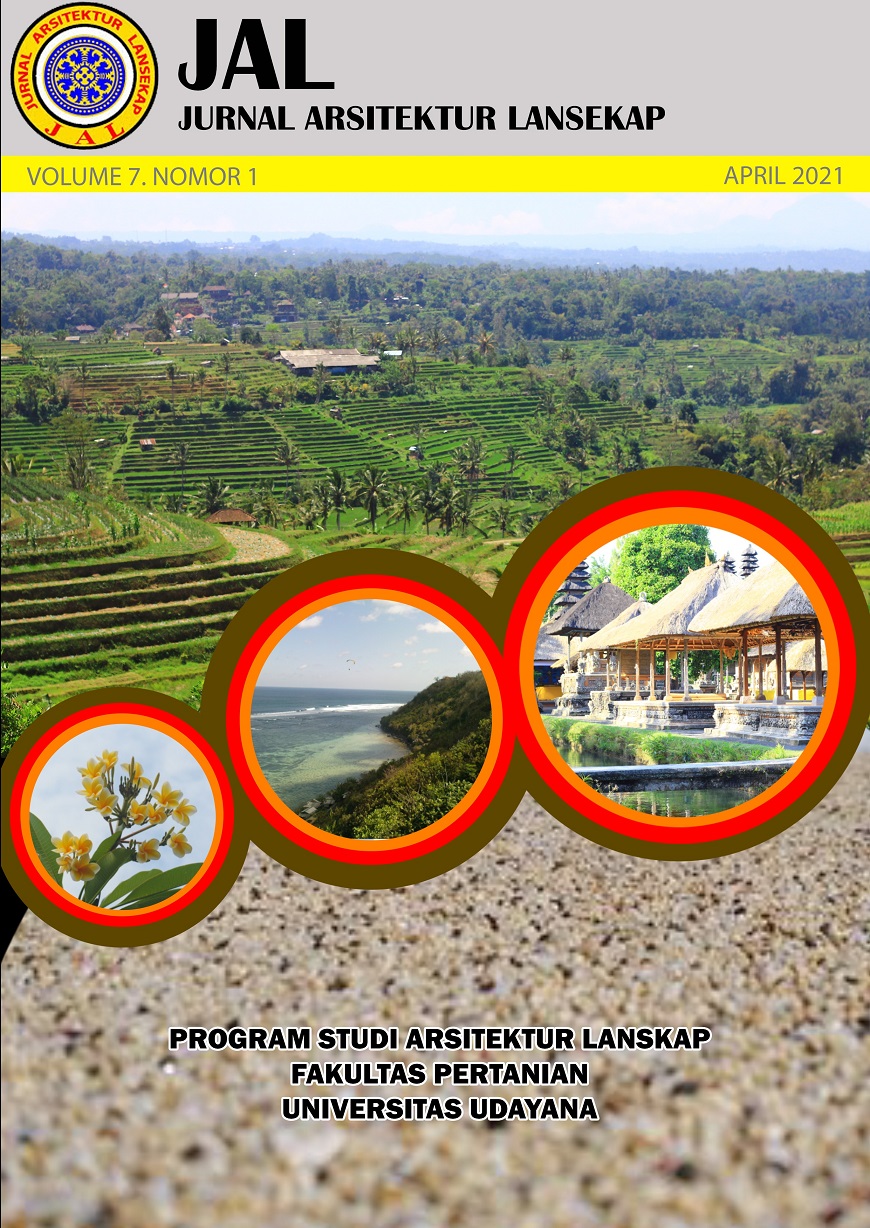Kajian signifikansi lanskap permukiman tradisional Pekon Hujung, Lampung Barat
Abstract
Pekon Hujung is a traditional settlement located in Belalau District, West Lampung Regency and directly adjacent to South Oku, South Sumatra Province that describes the character of the Lampungnese people. The rapid pace of urban development and modernization can shift the cultural values that exist in a traditional settlement and its environment. One of the negative impacts that may arise is the loss of cultural importance in a traditional settlement area. An assessment of the importance or significance of a culture can be carried out as one way of determining an appropriate conservation strategy. This study was conducted to identify and to analyze the key characters that formed Pekon Hujung cultural landscape. The method used in this study is the Cultural Heritage Landscape Assessment (CHLA) which is used to assess the significance or importance of a landscape. The assessment resulted in important value score of 27, which was cllassified as high category of the landscape importance. In general, Pekon Hujung has distinctive character, where the supporting elements, as well as the people still live and carry out the cultural values that have existed since long ago. The Pekon Hujung landscape is a culture that has important values and local wisdom which can still be applied in today's life.
Downloads
References
Badan Pusat Statistik Kabupaten Lampung Barat. 2020. Kabupaten Lampung Barat dalam Angka. BPS Kabupaten Lampung Barat, Lampung Barat.
Direktorat Tradisi, Direktorat Jenderal Nilai Budaya Seni dan Film. 2011. Arsitektur Tradisional Daerah Lampung. Balai Pustaka, Jakarta.
Harris CW, Dines NT. 1988. Time-Saver Standards for Landscape Architecture: Design and Construction Data. The McGrawHill Companies, New York.
Heritage Council of Victoria. 2009. Landscape Assessment Guidelines for Cultural Heritage Significance. Heritage Council of Victoria, Melbourne.
Ibrahim, W. dan Nandang. 2011. Arsitektur Tradisional Kenali Salah Satu Kearifan Lokal Daerah Lampung. Jurnal Rekayasa 15(1):59-66.
International Council on Monuments and Sites. 1999. The Burra Charter: The Australia ICOMOS Charter for Places of Cultural Significance. Burra: Australia ICOMOS.
Lestari dan Fadhili. 2020. Tipologi Grid Kolom Pada Lamban Pekon Hujung di Lampung Barat. Jurnal Arsitektur 10(1):1-6.
Malim, D.D.L.O., Sumantri, I., Tahara, T. 2019. Inventarisasi dan Pengembangan Potensi Cagar Budaya Kota Baubau. Kainawa: Jurnal Pembangunan & Budaya 1(1):1-15.
Pemerintah Kabupaten Lampung Barat. 2012. Peraturan Daerah Kabupaten Lampung Barat Nomor 1 Tahun 2012 tentang Rencana Tata Ruang Wilayah Kabupaten Lampung Barat Tahun 2010-2030. Pemkab Lampung Barat, Liwa.
Pratiwi, R. A., & Gunawan, A. 2017. Study of Lampungnese Traditional Home Garden Design. IOP Conference Series: Earth and Environmental Science 91(1):1–8. https://doi.org/10.1088/1755-1315/91/1/012024
Putri, Y.Y., Gunawan, A., dan Arifin, N.H.S. 2013. Kajian Lanskap Permukiman Tradisional Masyarakat Lampung Saibatin di Pekon Kenali, Lampung Barat. Jurnal Permukiman 8(3):153-167.
Widiati, I.R. 2016. Kajian Struktur Rumah Tradisional Papua (Honai). Jurnal Ilmiah Teknik dan Informatika, 1(1):18-23.
An author who publishes in the Jurnal Arsitektur Lansekap (JAL) agrees to the following terms:
- Author retains the copyright and grants the journal the right of first publication of the work simultaneously licensed under the Creative Commons Attribution-ShareAlike 4.0 License that allows others to share the work with an acknowledgement of the work's authorship and initial publication in this journal
- Author is able to enter into separate, additional contractual arrangements for the non-exclusive distribution of the journal's published version of the work (e.g., post it to an institutional repository or publish it in a book) with the acknowledgement of its initial publication in this journal.
- Author is permitted and encouraged to post his/her work online (e.g., in institutional repositories or on their website) prior to and during the submission process, as it can lead to productive exchanges, as well as earlier and greater citation of the published work (See The Effect of Open Access).
Read more about the Creative Commons Attribution-ShareAlike 4.0 Licence here: https://creativecommons.org/licenses/by-sa/4.0/.







